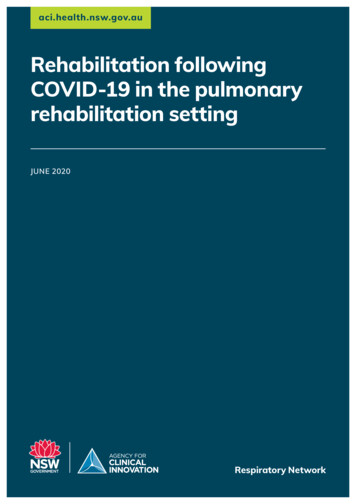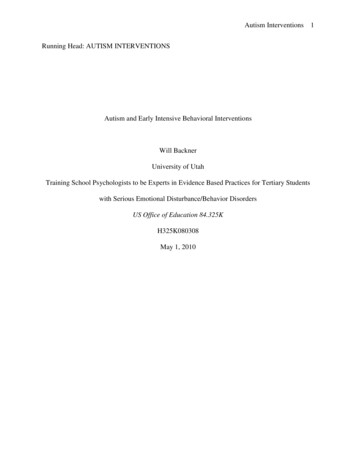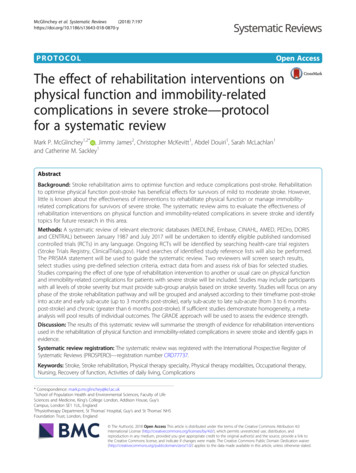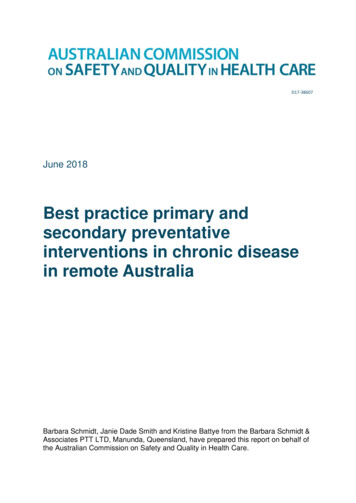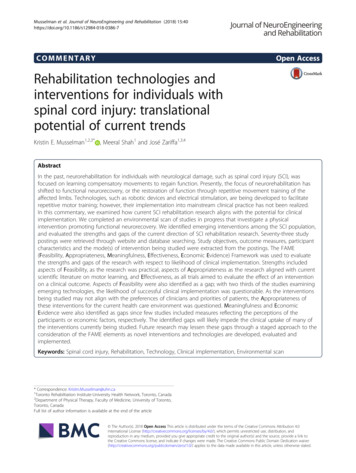
Transcription
Musselman et al. Journal of NeuroEngineering and Rehabilitation (2018) ENTARYOpen AccessRehabilitation technologies andinterventions for individuals withspinal cord injury: translationalpotential of current trendsKristin E. Musselman1,2,3* , Meeral Shah1 and José Zariffa1,3,4AbstractIn the past, neurorehabilitation for individuals with neurological damage, such as spinal cord injury (SCI), wasfocused on learning compensatory movements to regain function. Presently, the focus of neurorehabilitation hasshifted to functional neurorecovery, or the restoration of function through repetitive movement training of theaffected limbs. Technologies, such as robotic devices and electrical stimulation, are being developed to facilitaterepetitive motor training; however, their implementation into mainstream clinical practice has not been realized.In this commentary, we examined how current SCI rehabilitation research aligns with the potential for clinicalimplementation. We completed an environmental scan of studies in progress that investigate a physicalintervention promoting functional neurorecovery. We identified emerging interventions among the SCI population,and evaluated the strengths and gaps of the current direction of SCI rehabilitation research. Seventy-three studypostings were retrieved through website and database searching. Study objectives, outcome measures, participantcharacteristics and the mode(s) of intervention being studied were extracted from the postings. The FAME(Feasibility, Appropriateness, Meaningfulness, Effectiveness, Economic Evidence) Framework was used to evaluatethe strengths and gaps of the research with respect to likelihood of clinical implementation. Strengths includedaspects of Feasibility, as the research was practical, aspects of Appropriateness as the research aligned with currentscientific literature on motor learning, and Effectiveness, as all trials aimed to evaluate the effect of an interventionon a clinical outcome. Aspects of Feasibility were also identified as a gap; with two thirds of the studies examiningemerging technologies, the likelihood of successful clinical implementation was questionable. As the interventionsbeing studied may not align with the preferences of clinicians and priorities of patients, the Appropriateness ofthese interventions for the current health care environment was questioned. Meaningfulness and EconomicEvidence were also identified as gaps since few studies included measures reflecting the perceptions of theparticipants or economic factors, respectively. The identified gaps will likely impede the clinical uptake of many ofthe interventions currently being studied. Future research may lessen these gaps through a staged approach to theconsideration of the FAME elements as novel interventions and technologies are developed, evaluated andimplemented.Keywords: Spinal cord injury, Rehabilitation, Technology, Clinical implementation, Environmental scan* Correspondence: Kristin.Musselman@uhn.ca1Toronto Rehabiltiation Institute-University Health Network, Toronto, Canada2Department of Physical Therapy, Faculty of Medicine, University of Toronto,Toronto, CanadaFull list of author information is available at the end of the article The Author(s). 2018 Open Access This article is distributed under the terms of the Creative Commons Attribution 4.0International License (http://creativecommons.org/licenses/by/4.0/), which permits unrestricted use, distribution, andreproduction in any medium, provided you give appropriate credit to the original author(s) and the source, provide a link tothe Creative Commons license, and indicate if changes were made. The Creative Commons Public Domain Dedication o/1.0/) applies to the data made available in this article, unless otherwise stated.
Musselman et al. Journal of NeuroEngineering and Rehabilitation (2018) 15:40BackgroundThe past three decades have seen a shift in the focus ofneurorehabilitation from the use of compensatoryapproaches to enable function toward an emphasis onfunctional neurorecovery, or promoting the restorationof function through use of the affected limbs. The shiftfrom compensation to neurorecovery has been most apparent in the rehabilitation of individuals with incomplete spinal cord injury (SCI) [1]. For example, 30 yearsago the rehabilitation of walking for those with incomplete SCI consisted of learning to use assistive devices.As basic research concerning the spinal control oflocomotion was translated to humans, the potential forthese individuals to recover independent walking abilitywas revealed. Through repetitive exposure to weightsupported stepping on a treadmill, spinal cats regainedsome walking function [2]. These discoveries, and theirsubsequent translation to humans with incomplete SCI[3], resulted in a paradigm shift from compensation toneurorecovery.Our understanding of the potential for neuroplasticityfollowing a SCI has contributed to the development ofintensive physical interventions that aim to promoteneurorecovery through repetitive movement training [4].To facilitate the intensive training process, therapeutictechnologies have been developed, such as exoskeletons,functional electrical stimulation (FES), and roboticrehabilitation devices. While clinicians have an interestin incorporating technology that may augment neurorecovery into practice, the actual uptake of technology inneurorehabilitation has been low [5–7].As consumers and providers of rehabilitative interventions, clinicians must consider client preferences, scientific evidence, previous clinical experience and availableresources (e.g. equipment, time, staffing) when choosingan intervention. The FAME (Feasibility, Appropriateness, Meaningfulness, Effectiveness and EconomicEvidence) framework was developed to assist clinicianswith the implementation of evidence-based practices[8, 9]. The framework outlines five elements to consider when deciding whether or not to implement anintervention or technology.1) Feasibility: whether the intervention is practical(i.e. concerned with the actual doing of somethingrather than theory) and practicable (i.e. the abilityto successfully implement into practice) given thecultural, physical and financial context.2) Appropriateness: whether the intervention fitswithin a therapeutic scenario and the currenthealth care context.3) Meaningfulness: whether the intervention andoutcomes matter to the target population, settingand culture. Meaningfulness relates to the personalPage 2 of 8experience, perceptions, values, thoughts, andbeliefs of each individual patient.4) Effectiveness: whether the intervention achieves theintended effect, which may be a clinical or healthservice outcome.5) Economic Evidence: whether the cost-to-benefitratio supports implementation of the intervention.While the intended users of the FAME framework areclinicians, knowledge translation and implementationare processes shared amongst the research and clinicalcommunities. Ideally researchers also consider theFAME elements when designing novel interventions andresearch studies for neurorehabilitation. Interventionsand technologies satisfying the FAME elements may beadopted more readily by clinicians and hence, makemore tangible impacts on patient outcomes and the neurorehabilitation field.Given the shift in the focus of SCI rehabilitation fromcompensation to neurorecovery, and the development oftechnology to support this direction, we wished toconsider how SCI rehabilitation research aligns with thepotential for clinical implementation. To do this wecompleted an environmental scan of current SCIrehabilitation research to: 1) Identify emerging physicalinterventions that aim to promote neurorecovery amongthe SCI population, and 2) Evaluate the strengths andgaps of the current direction of SCI rehabilitationresearch using the FAME framework as a guide forevaluation.MethodsAn environmental scan of clinical trials for the SCIpopulation was completed from June 8–July 5 2017.Environmental scans are often performed to examine afield as a whole in order to provide evidence of itscurrent direction, to raise awareness of issues or gaps,and to plan future initiatives and strategies [10].Search strategiesSources of information included databases or websitesthat list ongoing research studies for SCI. Due to thetime lag between the conduct and publication ofresearch studies, we examined research currently beingconducted and not yet published. Nine websites listingSCI research studies were accessed: ClinicalTrials.gov,Craig H. Neilsen Foundation, Spinal Cord OutcomesPartnership Endeavor, International Collaboration OnRepair Discoveries, Wings for Life, Unite 2 Fight Paralysis, and Rick Hansen Institute, whose website also directed us to the websites for Spinal Cord Injury Ontarioand Spinal Cord Injury Alberta. The research studieslisted on these websites were reviewed by two authors
Musselman et al. Journal of NeuroEngineering and Rehabilitation (2018) 15:40(MS, KEM) to identify studies adhering to the followinginclusion/exclusion criteria:Inclusion criteria: Participants included individuals with SCI(traumatic or non-traumatic cause) aged 16 yearsat any time since injury (i.e. 1 year post-injury oracute/sub-acute, and 1 year post-injury orchronic). The primary intervention(s) being studied was aphysical intervention (not a surgical,pharmacological or cell-based intervention)that aimed to promote neurorecovery. Study status was either active but not yet recruiting,recruiting, enrolling, or data collection complete butnot yet published.Exclusion criteria: Studies with an unknown status that had not beenupdated in 2 years, or for which published resultswere found. Insufficient study information ( 50% of study detailswere missing, see Data Extraction below). Cross-sectional studies (i.e. studies involving a singleexposure to a physical intervention as this wasunlikely to induce neurorecovery).All study postings were reviewed on each website, withthe exception of Clinicaltrials.gov where a search wasperformed. The search criteria used reflected the aboveinclusion and exclusion criteria.Data extraction and synthesisInformation about each included study was extractedfrom the website and compiled into a data extractiontable by one author (MS). Information gathered included: source of study posting, study status, location ofstudy, study objectives, outcome measures, and injurycharacteristics of the targeted participants, such asneurological levels of injury and time since injury. Wealso documented whether the study included an evaluation of the economic feasibility, participants’ perspectives (e.g. qualitative interviews) and an assessment ofthe clinical utility (i.e. ease of use in a clinical environment) of the intervention(s) being examined.Each study was classified by the type or mode of physical intervention used. Due to our focus on interventionsthat promote neurorecovery, we anticipated that the majority of interventions would be activity-based therapies(ABT). With ABT neuroplasticity is driven by repetitiveneuromuscular activation below the level of spinal injury, typically achieved through intensive, task-specificmovement practice. Some modes were anticipated inPage 3 of 8advance and identified a priori; for example, robotics,virtual reality, electrical stimulation, and repetitivemovement training without emerging technology (e.g.treadmill or overground gait training). Interventionsusing electrical stimulation were further divided intothree groups according to the site of stimulation: brain,spinal cord or peripheral nervous system (i.e. FES). Thetarget function of the intervention was also noted (i.e.upper extremity function, lower extremity function, and/or trunk function).Evaluation of strengths and gapsThe strengths and gaps of current SCI rehabilitationresearch were identified through consideration of thefive FAME elements and the environmental scan results.Feasibility was divided into separate evaluations ofwhether the studied intervention was practical andpracticable, and Appropriateness was divided into foursub-elements: institution, clinician, patient and scientificevidence. The authors determined, through consensus,whether each element or sub-element reflected astrength or a gap. Answering ‘yes’ to the following guiding questions suggested that the element was a strength.1) Feasibility: Practical: Does the study involveapplication of an intervention to a targetpopulation? Practicable: Does the study involve anintervention that is clinically feasible? For example,an intervention requiring specialized equipmentand/or knowledge or training would be consideredless clinically feasible. Is a measure of clinical utilityincluded in the study?2) Appropriateness: Institution: Do hospitals/rehabilitation centers commonly have the resources(e.g. space, manpower, finances) required toadminister the intervention? Clinician: Is theintervention likely to meet the needs of clinicians?For example, does it reflect real-world tasks, measure performance, and encourage variability inmovement patterns while simultaneously preventingpractice of compensatory movement strategies [6]?Patient: Is the intervention likely to meet the needsof individuals with SCI participating in rehabilitation,given their priorities [11] and stage of recovery?Scientific Evidence: Does the intervention align withprinciples of motor learning and neuroplasticity [12]?For example, does the intervention involve motorpractice that is task-specific and intensive (i.e. manyrepetitions), and elicits voluntary participation fromthe patient?3) Meaningfulness: Does the study includedocumentation of the participants’ perspectives onthe intervention and/or its intended outcome?Meaningfulness may be assessed through qualitative
Musselman et al. Journal of NeuroEngineering and Rehabilitation (2018) 15:40methods, such as semi-structured interviews orfocus groups, or through goal attainment scaling.Structured questionnaires may also probemeaningfulness, albeit without the depth ofunderstanding provided by qualitativemethodologies.4) Effectiveness: Does the study include evaluation ofthe effect of the intervention?5) Economic Evidence: Does the study includeevaluation of economic factors?ResultsEnvironmental scan resultsA total of 1614 study postings were found. After de-duplicating and screening for inclusion, 73 studies were included. Sixty-nine of the 73 studies were returned in theClinicalTrials.gov database. This database involves a review process that provides standardization for study description; hence, the quality of study postings washigh for the majority of included postings. Most studies (n 49, 67%) were actively recruiting participants(Table 1). The majority of research studies were beingconducted in North America (n 54, 74%) or Europe(n 15, 21%). Two studies were being completed inThailand, one in Israel and one in China. The bias of inclusion toward the western world likely reflects the sources ofinformation accessed for the environmental scan.Table 1 Study and participant characteristicsStudy status7 (10%)Actively recruiting49 (67%)Ongoing study, no longer recruiting10 (14%)Data collection complete3 (4%)Not specifieda4 (5%)Participant CharacteristicsInjury Severity:Incomplete33 (45%)Complete3 (4%)Incomplete & complete9 (12%)Not specified28 (39%)bTime Since InjuryaGiven our focus on neurorecovery, it was notsurprising that the sub-group of SCI most commonlytargeted was individuals with incomplete SCI (n 33,45%) (Table 1). Participants with chronic injuries(37%, n 27) were more commonly targeted thanthose with sub-acute SCI (n 7, 10%).Electrical stimulation was the mode of interventionbeing studied in 20 studies (27%) (Table 2). Variousapplications of brain stimulation were being investigated, as was epidural stimulation of the spinal cord,and surface or implanted FES systems for the upperor lower limbs and/or trunk. Sixteen studies (22%)were examining repetitive movement training withoutthe use of emerging technology, such as overgroundgait training, balance exercises, upper limb exercisesand dance/yoga, to name a few (Table 2). ABT withrobotic devices were being investigated in 15 studies(21%); with the majority employing lower extremityexoskeletons or the Lokomat . Six study postingsdescribed research on the effects of intermittent hypoxiaon voluntary movement and function, primarily of thelower extremity. Five research studies were incorporatinga form of virtual reality into the ABT. Nine studies (12%)employed a combination of two forms of electrical stimulation, such as brain stimulation paired with peripheralnerve stimulation (i.e. paired associative stimulation), or acombination of stimulation with movement practice usinga robotic device.Strengths and gapsNumber of studies(% of sample (n 73))Not yet recruitingPage 4 of 8Chronic27 (37%)Sub-acute7 (10%)Chronic & sub-acute28 (38%)Not specified11 (15%)Study status not reported, but published study results were not foundbChronic 1 year post-injury; sub-acute 1 year post-injuryThe FAME elements of feasibility (practical), appropriateness (scientific evidence), and effectiveness were identified as strengths of current SCI rehabilitation research,while the remaining FAME elements were deemed to begaps (see Table 3).1) Feasibility: Current SCI rehabilitation research ispractical; it is concerned with the application ofinterventions. The interventions being researchedare less practicable. Two thirds of the researchinvolved electrical stimulation, robotics, virtualreality, or a combination of these technologies, all ofwhich require specialized equipment andknowledge. Ten research postings (14%) listed ameasure of clinical utility among the studyoutcomes.2) Appropriateness: Institution: Financial, staffing andspace constraints likely limit the appropriateness ofthe interventions currently being studied. Theexpertise required to operate and to repairemerging technology, such as robotic devices andbrain stimulation, is typically not found amongstthe neurorehabilitation team.
Musselman et al. Journal of NeuroEngineering and Rehabilitation (2018) 15:40Table 2 Intervention characteristicsPage 5 of 8Table 2 Intervention characteristics (Continued)Number of studies(% of total (n 73))Number of studies(% of total (n 73))ModeTrunk (seated balance)1 (1%)Electrical stimulation20 (27%)LE & UE10 (13%)Brain8 (11%)UE & trunk1 (1%)tDCS2 (3%)rTMS4 (5%)DBS2 (3%)Spinal Cord4 (5%)Epidural4 (5%)PNS (i.e. FES)8 (11%)Surface FES for UE4 (5%)Surface FES for UE and LE (cycling)1 (1%)Implanted FES for LE2 (3%)Implanted FES for trunk1 (1%)Repetitive Movement TrainingaOverground gait training16 (22%)5 (7%)“Locomotor training”b2 (3%)BWSTT1 (1%)TT in aquatic environment1 (1%)Cycling1 (1%)Dance/yoga1 (1%)Balance exercises1 (1%)Weight-bearing exercisesc2 (3%)UE exercises2 (3%)Robotics15 (21%)LE exoskeleton9 (12%)Lokomat3 (4%)UE robotic device (1 brain-controlled)2 (3%)LE & UE robotic device1 (1%)Combination9 (12%)aWithout technology or therapeutic assistive devicesbDetails of locomotor training not specifiedcSit-to-stand exercises in one studydAim is to affect sensory and motor function. tDCS transcranial direct currentstimulation; rTMS repetitive transcranial magnetic stimulation; DBS deepbrain stimulation; PNS peripheral nerve stimulation; FES functional electricalstimulation; LE lower extremity; UE upper extremity; BWSTT body weightsupported treadmill training; TT treadmill training; SC spinal cord;SCI spinal cord injuryClinician: Although many of the interventions attemptto mimic real-world tasks, such as overground walking,the extent to which the interventions emphasize thequality of movement (i.e. minimization of compensatorymovement strategies) is not clear.Patient: Lower extremity function, including walking,was most commonly targeted by the studies (n 46,63%). However, regaining arm and hand function is thetop priority for individuals with incomplete tetraplegia[11], who represent 45% of the SCI population [13]. Inaddition, little research (n 2, 3%) was focused onimproving trunk function, which is a prerequisite foreffective movement of the upper limb. Furthermore, SCIrehabilitation research is focused on chronic SCI, mostlikely to eliminate the effects of natural recovery.Inclusion of participants with sub-acute SCI wouldbe more appropriate for the therapeutic context(i.e. inpatient and outpatient rehabilitation), and alignswith the window of opportunity for neuroplasticity [4, 12].Scientific Evidence: Many of the interventions beingstudied were designed with the principles of motorlearning and neuroplasticity in mind. The majority ofinterventions involved repetitive, task-specific movementTwo types of stimulation (i.e. brain SC or FES)6 (8%)Robotics stimulation (i.e. brain or SCI)3 (4%)Table 3 Strengths and gapsIntermittent Hypoxia6 (8%)FAME ElementLE function5 (7%)FeasibilityUE function1 (1%)Practical 5 (7%)Practicable–Walking/LE function3 (4%)AppropriatenessUE function & trunk (virtual sailing)1 (1%)Institution–1 (1%)Clinician–1 (1%)Patient–Virtual RealityNot specifiedWhole-body vibration (LE)Low-level laser therapyd1 (1%)Scientific EvidenceMeaningfulnessTarget Function –LE46 (63%)Effectiveness UE15 (22%)Economic Evidence– indicates a strength; indicates a gap
Musselman et al. Journal of NeuroEngineering and Rehabilitation (2018) 15:40training. The exceptions were studies (n 8, 10%) evaluating the effects of intermittent hypoxia, whole bodyvibration and low-level laser.3) Meaningfulness: Only five studies (7%) documentedthe participants’ perspectives on the effects of anintervention (i.e. Canadian OccupationalPerformance Measure (n 3) or a semi-structuredinterview (n 2)). An additional six (8%) included aquestionnaire about participants’ opinions on thedevice or intervention being tested. About one thirdof studies included a measure of quality of life;however, quality of life and meaningfulnessmay not equate.4) Effectiveness: The majority of studies includedmeasures of body structure and function or activityaccording to the International Classification ofFunctioning, Disability and Health (ICF) [14].Measures of gait (n 41, 56%), balance/posturalcontrol (n 25, 34%), upper extremity function(n 19, 26%), independence (n 19, 26%), strength(n 17, 23%), and sensorimotor function (e.g. theInternational Standards for NeurologicalClassification of SCI (ISNCSCI) exam, motorevoked potentials) (n 11, 15%) were included.5) Economic Evidence: Only two of the 73 studies (3%)mentioned evaluating one or more economicfactors. One study planned to document thenumber of staff required during two modes oflocomotor training, as well as other economicfactors that were not specified in the posting. Thesecond study planned to evaluate whetherlocomotor training affects the use of a personalcare attendant and/or in-home nursing care.DiscussionWe completed an environmental scan to identify 73active studies researching physical interventions thatpromote neurorecovery among adults with SCI.Emerging interventions included repetitive movementpractice supplemented with technology, such as roboticdevices, virtual reality and electrical stimulation of thecentral or peripheral nervous systems. What is the likelihood that these interventions can be successfully implemented into clinical practice? The clinical uptake ofthese technologies into SCI rehabilitation has receivedlittle study to-date; however, previous work in strokerehabilitation would suggest the likelihood is not high.FES, robotics and Wii or Kinect systems are infrequentlyused by clinicians working with individuals who haveexperienced a stroke [5–7]. Numerous barriers to theclinical implementation of rehabilitative technologyexist. For example, a lack of knowledge about the technology combined with little or no allocated time to learnPage 6 of 8[6, 7]. The technology may be perceived too timeconsuming to set-up and/or administer, detracting froma patient’s allocated therapy time [6, 7]. Technologiesmay be perceived to disrupt clinician-patient interactions[6]; for example, physical therapists prefer to use theirhands to facilitate movement rather than FES [7].There are financial barriers as well. The cost andmaintenance of some technologies may exceed what aclinical environment can afford. Identifying andaddressing barriers early in the development andstudy of interventions is crucial for the research toclinical translation [15].The Effectiveness element of the FAME frameworkwas considered a strength of current SCI rehabilitation research. The evaluation of the effects of anintervention can occur under controlled conditions,such as in a laboratory setting; referred to as an efficacy trial [16]. Alternatively an intervention may bestudied under ‘real-world’ conditions, as would be thecase if the study setting was a hospital and/or with aheterogeneous group of patients; this is an effectiveness trial [16]. While the FAME Framework does notdistinguish between efficacy and effectiveness, webelieve it is important to acknowledge that these twotypes of trials address different research questions,with efficacy trials evaluating whether an interventionworks and how large the effect is, and effectivenesstrials evaluating whether the intervention’s efficacypersists in clinical practice [16]. We suspect that themajority of studies included in the environmentalscan were efficacy trials. Moving forward, the study ofSCI rehabilitation interventions should includeefficacy trials followed by evaluations of effectivenessif efficacy was achieved, as this process is likely tofacilitate the identification of barriers and implementation in clinical environments.From the environmental scan it seemed that fewstudies planned to evaluate relevant economic factors;however, it is possible that a separate economic analysiswas planned, but not reported. Further, the two studiesthat included an economic aspect specified resourceutilization (i.e. staffing) as the focus. It may be that moredetailed and lengthy economic analyses, such as thenumber of quality-adjusted-life-years (QALY) affordedby an intervention [15], are not considered until theeffectiveness of an intervention is established. It hasalso been suggested that unfavorable findings fromeconomic analyses can stall the research of noveltechnologies that only benefit a small group ofpeople, such as those with SCI [15]. Hence, theremay be justification to perform economic analyses ata later stage in the research process.In sum, there are gaps in current SCI rehabilitation research that will likely impede the clinical implementation
Musselman et al. Journal of NeuroEngineering and Rehabilitation (2018) 15:40of many of the interventions under investigation.Future research should aim to lessen these gapsthrough consideration of the FAME Frameworkduring the development, evaluation and implementationof novel rehabilitation interventions or technologies. Wesuggest a staged approach to the consideration of FAMEelements (Fig. 1). For example, in the early stage of uncontrolled trials, researchers may consider the Feasibility(practicality) and begin an evaluation of Appropriatenessby considering the face validity of the intervention. Thismay involve scanning relevant literature and elicitinginput from end-users. Incorporating feedback from clinicians into the design of interventions, or adopting usercentered designs, may lessen the gap between the interventions being studied and the therapeutic context [15].Following this early stage, controlled or efficacy trials areencouraged to collect data concerning Meaningfulness, efficacy (Effectiveness) and Economic factors (i.e. costs andresource utilization), in addition to the ongoing consideration of practicality (Feasibility) and Appropriateness. Itwould also be an appropriate time to consider the clinicalutility of the intervention and anticipate the barriers to itsimplementation – i.e., how practicable the intervention is(Feasibility). Finally, the Effectiveness of the interventionmay be evaluated, as well as consideration of the Appropriateness of the intervention at the level of the healthcare institution. An Economic analysis that considers cost:benefit or QALY may also be completed. By consideringthe FAME Framework throughout the research process,the successful translation of novel interventions or technologies from research to clinical practice may be realized.Page 7 of 8While the FAME elements provide a framework tocomprehensively evaluate the translational potential ofnew rehabilitation interventions, it is important toconsider the elements of the model together ratherthan in isolation. For example, if an intervention isfound to be highly effective, a consensus may bereached that some modifications to clinical processesare warranted in order to incorporate the newtechnique. These modifications might in turn entail areevaluation of feasibility considerations.ConclusionIn current SCI rehabilitation research, the use oftechnology to augment physical interventions was foundto be common; however, the feasibility, appropriateness,meaningfulness and economic impact of these newtherapies require greater consideration. Ongoingdialogues between clinicians and researchers can ensurethat new technologies and ideas are vetted rigorouslywhile informing changes to practice that will maximizeoutcomes for individuals with SCI.Additional fileAdditional file 1: Supplementary Info - Data Extraction Table JNER.(XLSX 91 kb)AbbreviationsABT: Activity-based therapies; BWSTT: Body weight-supported treadmill training; DBS: Deep brain stimulation; FAME: Feasibility, Acceptability,Meaningfulness, Effectiveness, Economic Evidence; FES: Functional electricalstimulation; LE: Lower extre
functional electrical stimulation (FES), and robotic rehabilitation devices. While clinicians have an interest in incorporating technology that may augment neurore-covery into practice, the actual uptake of technology in neurorehabilitation has been low [5-7]. As consumers and providers of rehabilitative interven-







